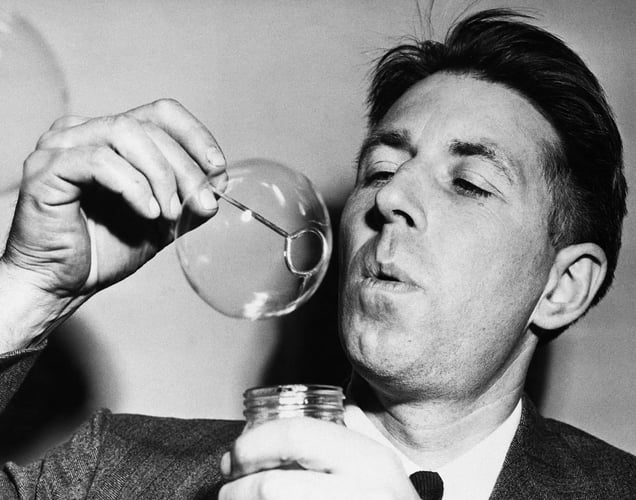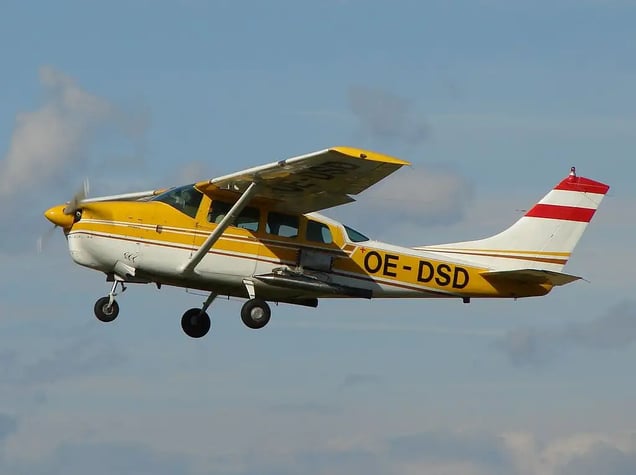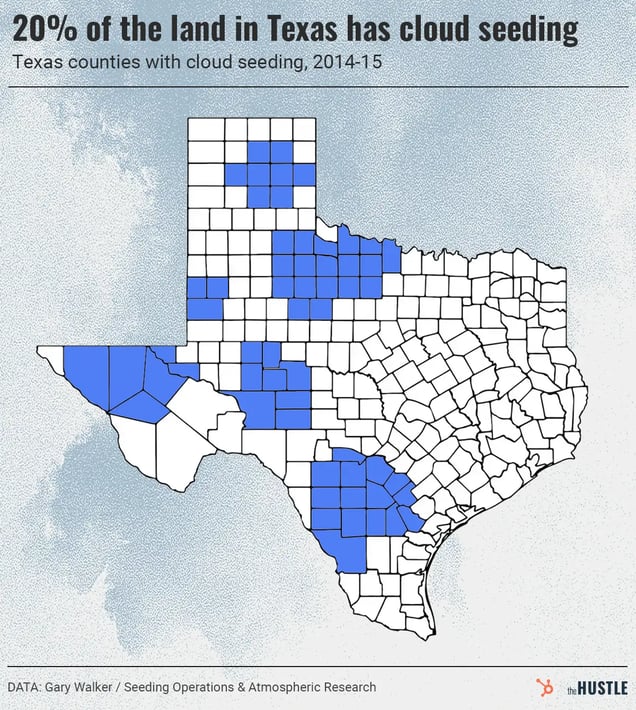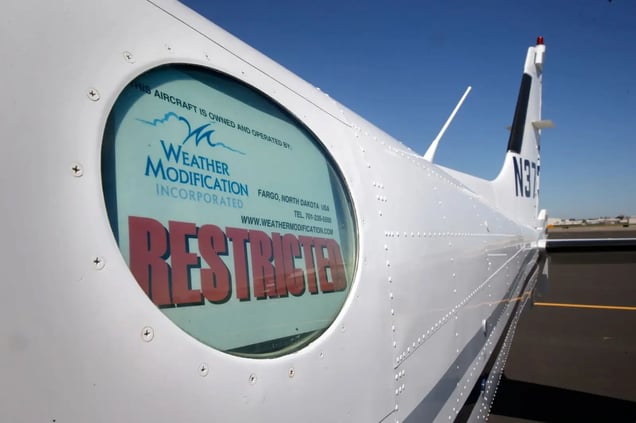On an average summer day, Gary Walker arrives early to his office in Stamford, Texas. He typically does some paperwork, maybe talks to his two fellow employees.

Much like a fireman, he’s waiting for a call. In his case, a call from his meteorologist. When the meteorologist forecasts imminent rain clouds, he tells Walker that it’s time to get in the air.
Walker then strides out of his office to the nearby hangar that houses his two airplanes, small craft built in the 1970s. But he trusts them to take him straight into storms that periodically darken the skies of this flat, agricultural area ~200 miles west of Dallas.
“I’ve cut my head quite a few times being bounced off the ceiling [of the plane],” Walker said. “It can be pretty rough.”
But the bumps and bruises are the cost of doing business. Walker’s company, SOAR, or Seeding Operations and Atmospheric Research, is paid to make it rain. Or, more accurately, to make it rain more than it would otherwise through a process known as cloud seeding.
Cloud seeding is not new. But when it makes national or international news — like when China used cloud seeding to try to keep rain out of Beijing during the 2008 Olympics — it tends to be greeted with skepticism, or even suspicions of Icarian arrogance.
Around the world, however, a niche group of people like Gary Walker have cloud-seeding contracts with government agencies, farmers, and business owners to increase rainfall or snowfall. Some of these weather-modification contracts have run continuously for decades.
But despite cloud seeders’ remarkable ability to harness the weather — and a need for more precipitation in much of the American West — their industry remains small. They can alleviate water shortages, but not solve them.
The cold box
During World War II, two scientists charged with keeping America’s planes from icing up in the far north became obsessed with clouds: Why did some drop snow while others, despite freezing temperatures, did not?
To test this question, General Electric scientists Vincent Schaefer and Irving Langmuir modified a freezer so they could observe the inside. Schaefer then exhaled into the freezer, effectively creating a vaporous cloud, and put different substances into the freezer.
When he plopped dry ice inside, ice crystals immediately formed. Schaefer was delighted: He’d made it snow.

Vincent Schaefer blows air bubbles in a freezing room in 1948 to explain how air contains the proper ingredients that lead to snow. (Bettmann via Getty Images)
Bernard Vonnegut — older brother of Kurt Vonnegut — became a collaborator and discovered that silver iodide, a compound structurally similar to ice crystals, was even more successful at coaxing snow and rain out of clouds.
- In a suitably moist cloud, tiny silver iodide particles will act as nuclei, with water vapor glomming onto them.
- More and more water vapor continues to accumulate until the ice crystal gets heavy enough to fall to the earth, as either snow or rain, depending on the temperature.
- For warm clouds, seeders often use hygroscopic particles (i.e., salt) in place of silver iodide, which works in a similar way.
When Kurt Vonnegut heard from his brother about cloud seeding, it inspired his novel Cat’s Cradle, about a substance that can instantly freeze liquid water. (Disaster ensues.)
But while Kurt dreamed up dystopian visions, Bernard, Langmuir, and Schaefer saw a promising scientific tool.
In November 1946, a GE pilot took Schaefer to create history’s first man-made snowstorm. Subsequent flights and research showed that, like in Schaefer’s “cold box,” silver iodide worked even better, making it the go-to material for manipulating the weather.
“A few pounds of silver iodide would be enough to nucleate all the air of the United States at one time,” Vonnegut wrote in 1947.
It wasn’t just effective; it was relatively cheap.

A Cessna with silver iodide generators. (Christian Jansky/Creative Commons)
But despite the scientists’ enthusiastic discovery of cloud seeding, it did not immediately spur a brave new world of governments and corporations modifying the weather.
- In late 1947, cloud seeding suffered a public-relations black eye when a Boeing B-17 flew into the eye of a hurricane hovering 350 miles offshore from Jacksonville, Florida.
- Langmuir believed that cloud seeding could disperse hurricanes before they made landfall by draining the clouds far from population centers, but the hurricane did not disperse, hitting Savannah, Georgia, at full force.
Proponents also had trouble overcoming questions about its legitimacy. As a cloud seeder put it to me, it’s not like “you’re creating different-colored snowflakes.” In other words: Weather is unpredictable. Who’s to say it wasn’t going to snow or rain that much anyway?
But the skepticism hasn’t stopped a handful of cloud-seeding businesses from taking flight.
Selling storms
As Gary Walker points his plane’s nose toward dark skies, his meteorologist is in his ear, directing him toward the best clouds based on radar data. Pilots typically try to avoid clouds that produce rain and storms. But Walker aims for them.
As he gets closer, the chop builds. Sudden lurches create moments of weightlessness.
“You keep track of which way to turn in case you need an escape route,” Walker said. “If you turn wrong and get deep into a cloud, that’s where you might be like Jonah in the whale. It might spit you out.”
Arriving at the cloud, Walker banks through it, firing silver iodide flares that line his wings like toy missiles. In tight circles, he might fire another few flares, or follow his meteorologist’s directions to another cloud.

Flares with silver iodide on the wings of one of Walker’s planes (Courtesy Gary Walker)
To Walker, these flights are rough but not dangerous — and more adventurous than his previous work.
Before he got into cloud seeding, Walker spent almost 30 years in water conservation. He lived in the Texas Panhandle, where farmers irrigate their fields by drawing on the Ogallala Aquifer, which provides drinking water to millions of residents from South Dakota to Texas, and irrigation for roughly a quarter of America’s farmland. It was also disappearing as farmers drew more water than can be replaced by rainfall.
“I drew depletion maps every year,” Walker said. “We were mining that aquifer to the tune of two, three, four feet a year. It was obvious mathematically that we were going to reach a point where we could no longer pump that water.”
So, in 1994, when Walker was elected to the Texas legislature, he helped pass a bill that provided state funding for cloud seeding to water conservation districts and county governments.
When he retired, he became the owner of SOAR. A few years ago, he had contracts with more than a dozen Texas counties. In Wichita County, SOAR could make as much as $300k per year depending on usage.
In Abilene, Texas, near his home base in Stamford, his cloud seeding might eke out an additional 1.5 inches of rain. It’s a significant amount for a growing season that sees 10 or 12 inches and has recently faced droughts.
“That can definitely make the difference between a farmer having something to sell or not making a crop,” Walker said.

The Hustle
While cloud seeding is no longer trumpeted on the cover of Time — like it was in Vonnegut and Langmuir’s day — its legitimacy has been verified by rigorous scientific studies, and it’s being implemented around the world for various uses:
- Agriculture: In Texas, Walker’s customers are primarily water boards formed by the state to do things like monitor wells, provide loans for water-saving irrigation sprinklers, and fund cloud seeding to benefit local cotton farmers.
- Ski resorts: Until the pandemic, one of the world’s oldest cloud-seeding contracts was Vail Resorts’ 44-year-running agreement with Western Weather Consultants to seed more snowfall for its Colorado ski runs. (Via land-based generators, rather than planes.)
- Replenishing reservoirs and aquifers: Many water boards contract cloud-seeding companies to augment reserves that supply homes, industry, and farms.
- Cooling cities: The Chinese government is the world’s most prolific cloud seeder, and its portfolio includes fighting heat waves with weather-modifying drones.
- Blue skies: China has used cloud seeding to keep rainfall out of Beijing during the Olympics — and during various summits and parades.
“It’s not as hard of a sell now, just due to the good research that has been done,” said Eric Hjermstad, whose father founded Western Weather Consultants in Colorado and signed the long-running contract with Vail Resorts.
‘Please stop playing God’
Building up the snowpack is essential in Colorado — to the multibillion-dollar ski industry, and to farmers and residents whose water comes from its summer runoff. Since the 1950s, the April snowpack in places like Colorado and the Western US has declined by 23%.
Yet Western Weather Consultants is a small business: three owners, one employee (his sister), and around $550k in annual revenue from contracts with districts in just two permit areas.

Ed Don of Colorado’s Western Weather Consultants works on a land-based cloud-seeding generator in 1977. (Denver Post via Getty Images)
The wider American cloud-seeding industry is similarly modest in size. Walker estimates the entire US industry at not even $10m a year. George Bomar of the Weather Modification Association similarly estimates the industry at below $10m.
Despite the need for more water in the West — the Colorado River Basin, which provides water to farmers and households in places like San Diego and Los Angeles, was at less than half its storage capacity in July even after a wet year — it remains a small industry.
- Like with any long-term investment, it can be challenging to convince legislators, farmers, or ski-resort owners to fund cloud seeding. The state of Texas, for example, has stopped contributing funding to share the costs of cloud seeding with local governments and water boards.
- Public skepticism can also block funding. A SOAR project in New Mexico, for example, was reduced in scope by the state’s “Stream Commission” after residents complained, including one who pleaded, “Please stop playing God with the weather.”
- Careful, consistent cloud seeding can only increase rainfall and snowfall so much. A widely cited Wyoming study, which found precipitation increases of 5%-15%, acknowledged that 15% was only in ideal conditions. Several additional inches over a season doesn’t end a drought, nor turn Phoenix into wetlands.
This last factor is the big limitation of cloud seeding. Compared to the cost of desalination plants or reworking the flow of rivers, cloud seeding is cost-efficient. (So much so that even scientists skeptical of its efficacy often acknowledge it’s still worth funding.) But its impact has a ceiling.
“We’ve got to work with what God gives us,” Walker said. “We don’t make it rain. We can only get more rain out of the cloud that God provides.”
Riches abroad?
Outside the United States, however, there is serious money to be made.
That’s because while cloud seeders in Idaho, Texas, and Colorado can use the federal government’s extensive radar systems and climate data, most other countries lack this comprehensive infrastructure and other know-how. They are willing to pay operators to show up with expensive equipment and trained pilots and meteorologists.

A cloud-seeding airplane in the Sierra foothills of California. (San Francisco Chronicle/Hearst Newspapers via Getty Images)
Walker has taken many contracts abroad, earning bigger rewards for the higher risk and extra work. He’s shipped large $500k radars to India and Mexico. But he stopped taking contracts abroad after a tense time seeding clouds in a part of Mexico wracked by drug-cartel violence.
Many countries also lack Americans’ skepticism of cloud seeding.
- China is the world’s most prolific cloud seeder, with regional weather-modification offices that employ around 40k people and conducted 500k weather operations from 2002 to 2012.
- That number has only grown as China launched national plans like the South-North Water Transfer Project and Sky River Project.
In a paper, scientists Shiuh-Shen Chien, Dong-Li Hong, and Po-Hsiung Lin of National Taiwan University have linked authoritarianism with increased cloud seeding and weather modification. They note that nondemocratic countries like to project power or chase prestige through massive, advanced infrastructure projects.
They also lack checks on implementation: Residents can’t tell the government to stop “playing God,” and dissenting opinions from scientists and politicians are often suppressed.
The Chinese market is not open to private cloud-seeding companies because the Chinese government runs its own operations. But other countries often look to private companies.
North Dakota-based Weather Modification Inc., for example, has made rainmaking a global business with multimillion-dollar contracts around the world, including a long-term, multimillion-dollar per year deal with Saudi Arabia. Those contracts have made it the relative behemoth of the industry.
For his part, Walker is happy to fly in Texas, bringing more summer rain to the region. He knows that water is necessary for so many people, for all of us. And when he looks down at his radar, or back at a cloud he seeded, he can see more of it getting down to people who need it.
Weather
